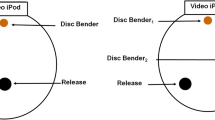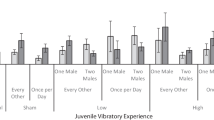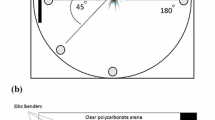Abstract
Effectiveness of natural stimuli (recorded and replayed male vibratory courtship signals) in eliciting a female's vibratory response was compared with that of synthetic stimuli in a plant-dwelling spider (Cupiennius salei). Specifically, the role of interseries (pauses between consecutive male series) was evaluated. Effectiveness was assessed by the number of responding females and the number of responses per female per stimulus. In case of both synthetic and natural stimuli, effectiveness increases with increasing duration of interseries in both measures. Interseries are thus represented in the female's innate releasing mechanism. However, synthetic stimuli are less effective (about 55%) than natural stimuli (set 100%). With decreasing interseries, the number of female responses per unit time sharply increases in case of playback of natural stimuli, but only slightly in case of synthetic stimuli. Since males courting on plants decrease interseries as soon as a female responds, thus facilitating their orientation, the data obtained with natural stimuli much better fit natural male courtship behaviour. This finding brings into question the validity of the synthetic stimulus. In the bioacoustics literature there is neither consensus on the effectiveness of a synthetic stimulus necessary to qualify it for behavioural analysis nor on how to measure effectiveness. We propose three measures : the percentage of responding animals, the action pattern of the response and the number of responses. It may be crucial, particularly when addressing evolutionary questions, to use either natural stimuli or synthetic stimuli (nearly) as effective as natural stimuli to avoid biased sampling of experimental animals and results difficult to interpret in biological terms.
Similar content being viewed by others
References
Arak A (1988) Female mate selection in the natterjack toad: active choice or passive attraction? Behav Ecol Sociobiol 22:317–327
Aubin T (1987) Respective parts of the carrier and of the frequency modulation in the semantics of distress calls. An experimental study on Sturnus vulgaris by means of digital synthesis methods. Behaviour 100:123–133
Barth FG (1982) Spiders and vibratory signals: sensory perception and behavioral significance. In: Witt PN, Rovner JS (eds) Spider communication: mechanisms and ecological significance. Princeton Univ Press, Princeton NJ, pp 67–122
Barth FG, Schmitt A (1991) Species recognition and species isolation in wandering spiders (Cupiennius specc., Ctenidae). Behav Ecol Sociobiol 29:333–339
Barth FG, Seyfarth E-A, Bleckmann H, Schüch W (1988a) Spiders of the genus Cupiennius Simon 1891 (Araneae, Ctenidae). I. Range distribution, dwelling plants, and climatic characteristics of the habitats. Oecologia 77:187–193
Barth FG, Bleckmann H, Bohnenberger J, Seyfarth E-A (1988b) Spiders of the genus Cupiennius Simon 1891 (Araneae, Ctenidae) II. On the vibratory environment of a wandering spider. Oecologia 77:194–201
Baurecht DK, Barth FG (1992) Vibratory communication in spiders. I. Representation of male courtship signals by female vibration receptor. J Comp Physiol A 171:231–243
Baurecht DK, Deutsch WA, Noll N, Barth FG (1989) Digital signal processing system: recording, analysis, synthesis and replay in bioacoustical experiments. In: Elsner N, Singer W (eds) Dynamics and plasticity in neuronal systems. G Thieme, Stuttgart, p 141
Date EM, Lemon RE, Weary DM, Richter AK (1991) Species identity by birdsong: discrete or additive information? Anim Behav 41:111–120
Doherty JA (1985a) Trade-off phenomena in calling song recognition and phonotaxis in the cricket, Gryllus bimaculatus (Orthoptera, Gryllidae). J Comp Physiol A 156:787–801
Doherty JA (1985b) Temperature coupling and trade-off phenomena in the acoustic communication system of the cricket, Gryllus bimaculatus. J Exp Biol 114:17–35
Doolan JM, Young D (1989) Relative importance of song parameters during flight phonotaxis and courtship in the bladder cicada Cystosoma saundersiii. J Exp Biol 141:113–131
Gaioni SJ (1982) Distress call alternation in Peking ducklings (Anas platyrhynchos). Anim Behav 30:774–789
Gerhardt HC (1981) Mating call recognition in the barking treefrog (Hyla gratiosa): responses to synthetic calls and comparisons with the green treefrog (Hyla cinerea). J Comp Physiol 144:17–25
Gerhardt HC (1991) Female mate choice in treefrogs: static and dynamic acoustic criteria. Anim Behav 42:615–635
Hearst E (1991) Psychology and nothing. Am Sci 79:432–443
Heiversen D von, Heiversen O von (1975) Verhaltensgenetische Untersuchungen am akustischen Kommunikationssystem der Feldheuschrecken (Orthoptera, Acrididae). II. Das Lautschema von Artbastarden zwischen Chorthippus biguttulus und C. mollis. J Comp Physiol 104:301–323
Huber F, Kleindienst HU, Weber T, Thorson J (1984) Auditory behavior of the cricket. III. Tracking of male calling song by surgically and developmentally one-eared females, and the curious role of anterior tympanum. J Comp Physiol A 155:725–738
Nisbett RW, Ross L (1980) Human inference. Prentice Hall, Englewood Cliffs, NJ
Peters SS, Searcy WA, Marler P (1980) Species song discrimination in choice experiments with territorial male swamp and song sparrows. Anim Behav 28:393–404
Ploog D (1971) The relevance of natural stimulus patterns for sensory information processes. Brain Res 31:353–359
Popper KR (1989) Conjectures and refutations. The growth of scientific knowledge. 5th ed. Routledge, London
Rosenthal RR, Rosnow RL (1984) Essentials of behavioral research. Methods and data analysis. McGraw Hill, New York
Schatral A, Bailey WJ (1991) Decisions during phonotaxis in the bushcricket Requena verticalis (Orthoptera: Tettigoniidae): do females change direction to alternative male calls? Ethology 88:320–330
Schmitt A, Schuster M, Barth FG (1992) Male competition in a wandering spider (Cupiennius getazi, Ctenidae). Ethology 90:293–306
Schüch W, Barth FG (1985) Temporal patterns in the vibratory courtship signals of the wandering spider Cupiennius salei Keys. Behav Ecol Sociobiol 16:263–271
Schüch W, Barth FG (1990) Vibratory communication in a spider: female responses to synthetic male vibrations. J Comp Physiol A 166:817–826
Searcy WA, Marler P, Peters SS (1981) Species song discrimination in adult female song and swamp sparrows. Anim Behav 29:997–1003
Siegel S, Castellan NJ (1988) Nonparametric statistics for the behavioral sciences. McGraw-Hill, New York
Surlykke A (1992) Target ranging and the role of time-frequency structure of synthetic echoes in big brown bats. J Comp Physiol A 170:83–92
Thorson J, Weber T, Huber F (1981) Auditory behavior of the cricket. II. Simplicity of calling-song recognition in Gryllus, and anomalous phonotaxis at abnormal carrier frequencies. J Comp Physiol 146:361–378
Weber T, Thorson J (1988) Auditory behavior of the cricket. IV. Interaction of direction of tracking with perceived temporal pattern in split-song paradigms. J Comp Physiol A 163:13–22
Weber T, Thorson J, Huber F (1981) Auditory behavior of the cricket. I. Dynamics of compensated walking and discrimination paradigms on the Kramer treadmill. J Comp Physiol 141:215–232
Author information
Authors and Affiliations
Rights and permissions
About this article
Cite this article
Schmitt, A., Friedel, T. & Barth, F.G. Importance of pause between spider courtship vibrations and general problems using synthetic stimuli in behavioural studies. J Comp Physiol A 172, 707–714 (1993). https://doi.org/10.1007/BF00195396
Accepted:
Issue Date:
DOI: https://doi.org/10.1007/BF00195396




